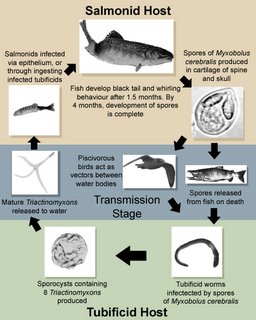
(Myxobolus cerebralis life cycle from http://en.wikipedia.org/wiki/Myxobolus_cerebralis)
As explained at http://www.wildlife.utah.gov/fes/whirling_disease.html, this critter has two hosts, a small annelid worm in the genus Tubifex (See also http://www.esg.montana.edu/aim/annelid/tubtub.html.) and any number of trout or salmon species. The parasite is yet another old world species that has accidentally been introduced to the United States where it causes problems. In this case since our native trout species did not coevolve with the parasite, they are susceptible to it.
Well darn, it doesn't have a really cool complex life cycle involving 20 intermediate hosts, a stage that looks like a ciliate only its photosynthetic , stuff like that. But a Google search turned up a link (http://research.amnh.org/~siddall/myxozoa/myxo.html) that made what to me was a startling claim. Namely that the Myxozoa are not Protista at all but highly reduced parasitic Cnidaria (that is at the risk of oversimplification...Jellyfish.!!!).
OK now this is more like it, but of course I want to see the evidence for this and what other scientists think of this idea. Not all radical ideas in science are reasonable contrary to what people who believe in the paranormal or in intelligent design and other superstitions believe. First, the idea that Myxozoa are related to Cnidaria is supported by the apparent homology between a Myxozoan stage called a polar body and the nematocyst ( a kind of stinging cell in Cnidaria). See Siddall's comparison at http://research.amnh.org/~siddall/myxozoa/cnid_char.html
His phylogeny based both on morphology and ribosomal RNA comparisons places the Myxozoa clearly in the Cnidaria, but I have not examined his data in more detail. In the Tree of Life's Project's phylogeny, the Myxozoa are currently placed as a questionable sister group to the Cnidaria, but firmly in the Metazoa-Metazoa an alternate term for the Kingdom Animalia. See also http://www.palaeos.com/Invertebrates/default.htm
The phylogeny of the Eukaryotes as arranged currently by the Tree of Life Project places the Metazoa and other animals, collared flagellates, Fungi and a group of parasitic organisms called microsporidia all together in a grouping called the Opisthokonts. Opisthokonts have a posterior flagellum in those stages of the life cycle that have motile cells as opposed to an anterior flagellum. Think of the difference between an animal sperm and a Euglena, the latter having an anterior flagellum that pulls the organism through it's medium. Seen in the context of Eukaryote evolution, animals are just part of this larger lineage which is in turn just a small section of eukaryote evolutionary history.
See Armstrong(http://www.bio.ilstu.edu/Armstrong/syllabi/222book/Chapt%203.htm) for a good review of Eukaryote Phylogeny. Indeed we are still trying to make sense of all the different eukaryote groups. Armstrong argues that the 'old' six Kingdom concept no longer is a viable idea since as the relationships between all the lineages becomes clearer the Kingdom Protista does not work for instance because Protista clearly are in the same evolutionary group or clade as plants, but distinct from the other Protista.
This gets into the whole area of cladistics, a method of attempting to reconstruct evolutionary or phylogenetic relationships between different groups of organisms. From the cladistic perspective a natural group has to include the common ancestor of all members of the group and it's descendents.
So what is an animal? Animals generally share or are derived from organisms that share the following characteristics:
- Animals are multicellular, usually with well differentiated tissues. But not always!
- Animals are generally diploid and produce haploid gametes via meiosis. In contrast plants produce spores by meiosis and gametes from haploid multicellular stages via mitosis.
- Animals are heterotrophic or more precisely chemoheterotrophs meaning that they get their energy and carbon from complex organic substances-hamburgers for instance.
- Animals cells do not have cell walls and animals are unable to digest cellulose, unlike many protists and bacteria. In fact those animals that ingest cellulose such as termites rely on a complex assemblage of single celled organisms in their gut to digest cellulose.
- Animals produce a diploid zygote from sexual reproduction involving the sperm and the egg and the zygote generally develops into a multicellular larval stage which primitively is free living.
There is an interesting discussion at the Berkeley site (http://www.ucmp.berkeley.edu/phyla/metazoamm.html) that makes a very interesting comment. Animal cells ultimately look very different from each other and the only really unique thing that distinguishes all animal cells from cells of other groups are differences in chemistry and metabolism. I have already mentioned that animal cells don't use and metabolize cellulose and this link notes that animal cells have a complex extracellular matrix made of glycoproteins, collagen. This extracellular matrix is important in animal cell adhesion, communication and development. In a sense, the extracellular matrix, mediates between the cell and it's surroundings. Indeed, all animals appear to have specialized protein receptors called integrins in their cell membranes that receive signals through and about the extracellular matrix.
Integrins are found in some Protista apparently (See http://receptome.stanford.edu/HPMR/Families/Frameset_family.asp?FamId=5&ProtType=Receptor)
but in animals they have a role in adhesion not found in Protists. So it seems that if one wants to look more closely at the origin of animals maybe these would be good proteins to examine.
So check back later this week for Part 2 of What is an animal...BLASTING for integrins.
Other links:
Myxozoan Network (http://www.iats.csic.es/~patolog2/about.htm)
The New Animal Phylogeny: Reliability and Implications
( http://www.pnas.org/cgi/content/full/97/9/4453)
Palaeos. (http://www.palaeos.com/Default.htm)
Evaluating hypotheses of basal animal phylogeny using complete sequences of large and small subunit rRNA (http://www.pnas.org/cgi/content/full/98/17/9707)
Technorati Tags:
Animals
Biology
No comments:
Post a Comment